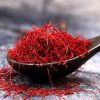History Of Saffron
Cultivation and use of saffron spans more than 3,500 years. It has been traded and used across continents and even utilized as a treatment for over 90 disorders. Ancient Greek legends speak of soldiers embarking on perilous voyages to procure what was thought to be the most valuable saffron. Cleopatra, as per certain texts, used saffron in her baths for its cosmetic properties. Egyptian healers used this spice for treating gastrointestinal ailments. And the Romans used it as a deodorizer.
Various conflicting accounts exist that describe saffron’s first arrival in South and East Asia. The first of these rely on historical accounts gleaned from Persian records. These suggest to many experts that saffron, among other spices, was first spread to India via Persian rulers’ efforts to stock their newly built gardens and parks. They accomplished this by transplanting the desired cultivars across the Persian empire. Another variant of this theory states that, after ancient Persia conquered Kashmir, Persian saffron crocus corms were transplanted to Kashmiri soil. The first harvest then occurred sometime prior to 500 BC. Phoenicians then began in the 6th century BC to market the new Kashmiri saffron by utilising their extensive trade routes. Once sold, Kashmiri saffron was used in the treatment of melancholy and as a fabric dye.
On the other hand, traditional Kashmiri legends state that saffron first arrived sometime during the 11th and 12th centuries AD, when two foreign and itinerant Sufi ascetics, Khwaja Masood Wali and Hazrat Sheikh Shariffudin, wandered into Kashmir. The foreigners, having fallen sick, beseeched a cure for illness from a local tribal chieftain. When the chieftain obliged, the two holy men reputedly gave them a saffron crocus bulb as payment and thanks. To this day, grateful prayers are offered to the two saints during the saffron harvesting season in late autumn. The saints, indeed, have a golden-domed shrine and tomb dedicated to them in the saffron-trading village of Pampore, India. However, the Kashmiri poet and scholar Mohammed Yusuf Teng disputes this. He states that Kashmiris had cultivated saffron for more than two millennia. Indeed, such ancient indigenous cultivation is alluded to in Kashmiri Tantric Hindu epics of that time. Ancient Chinese Buddhist accounts from the Mula- sarvastivadin monastic order (or vinaya) present yet another account of saffron’s arrival in India. According to legend, an arhat Indian Buddhist missionary by the name of Madhyântika (or Majjhantika) was sent to Kashmir in the 5th century BC. When he got there, he reportedly sowed Kashmir’s first saffron crop. From there, saffron use spread throughout the Indian subcontinent. In addition to use in foods, saffron stigmas were also soaked in water to yield a golden-yellow solution that was used as a fabric dye. Such was the love of the resulting fabric that, immediately after the Buddha Siddhartha Guatama’s death, his attendant monks decreed saffron as the official colour for Buddhist robes and mantles.
 The 17.8 m monolith of Jain prophet Bhagavan Gomateshwara Bahubali, which was carved between 978–993 AD and is located in Shravanabelagola, India, is anointed with saffron every 12 years by thousands of devotees as part of the Mahamastakabhisheka festival
The 17.8 m monolith of Jain prophet Bhagavan Gomateshwara Bahubali, which was carved between 978–993 AD and is located in Shravanabelagola, India, is anointed with saffron every 12 years by thousands of devotees as part of the Mahamastakabhisheka festival




